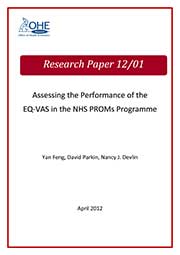Sign up to our newsletter Subscribe
Analysing Global Immunisation Expenditure

The NHS Patient Reported Outcome Measures (PROMs) programme, introduced in April 2009, is a significant development in the routine collection and use of patient reported outcome data. Data currently are collected for patients both before and after surgery for four elective surgical procedures…
The NHS Patient Reported Outcome Measures (PROMs) programme, introduced in April 2009, is a significant development in the routine collection and use of patient reported outcome data. Data currently are collected for patients both before and after surgery for four elective surgical procedures in the NHS, with plans to expand the practice.
Results from the PROMs data already are being used in a broad range of decision making contexts. For example, comparisons of the changes in patient health before and after surgery are being used as one indicator of hospital performance. The data also are being used by commissioners in evaluating the effectiveness and cost effectiveness of services. Ensuring that the data are as accurate and reliable as possible, therefore, is crucial.
The EQ-5D, used to collect the PROMs data, has two parts. The first, the EQ-5D profile, asks patients to classify their health based on levels of problems (“no”, “some”, ”extreme”). The second is the EQ-VAS, which asks patients to indicate their overall health on a vertical visual analogue scale.
This paper focuses on two concerns about the EQ-VAS: (1) difficulties with the data because patients may fail to use the scale properly and (2) substantial differences between patient responses on the EQ-VAS and on both the EQ-5D and condition specific instruments. These raise fundamental questions about the role and use of EQ-VAS in the EQ-5D instrument.
The aim of this paper is to improve understanding of the EQ-VAS data as a prelude to creating better ways of collecting, coding and analysing them. It investigates the causes of the alleged problems with EQ-VAS data in the PROMs programme and the extent to which these account for the observed differences between EQ-VAS, profile and index weighted profile data.
A revised version of this paper has been published in Quality of Life Research and can be downloaded from: http://link.springer.com/article/10.1007%2Fs11136-013-0537-z
Please cite as: Feng, Y., Parkin, D. and Devlin, N.J., 2014. Assessing the performance of the EQ-VAS in the NHS PROMs programme. Quality of Life Research, 23(3), pp.977-989.
Assessing the Performance of the EQ-VAS in the NHS PROMs Programme
